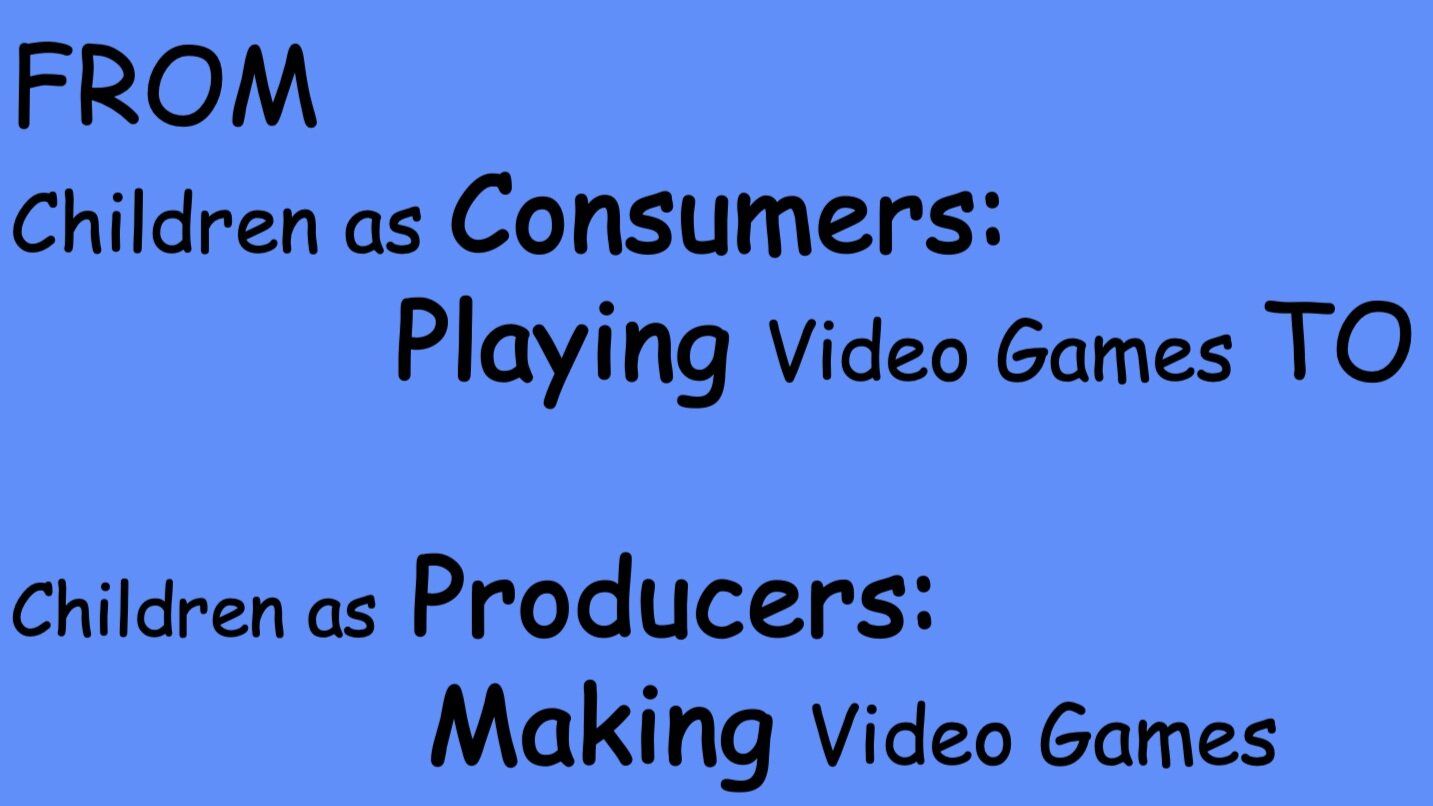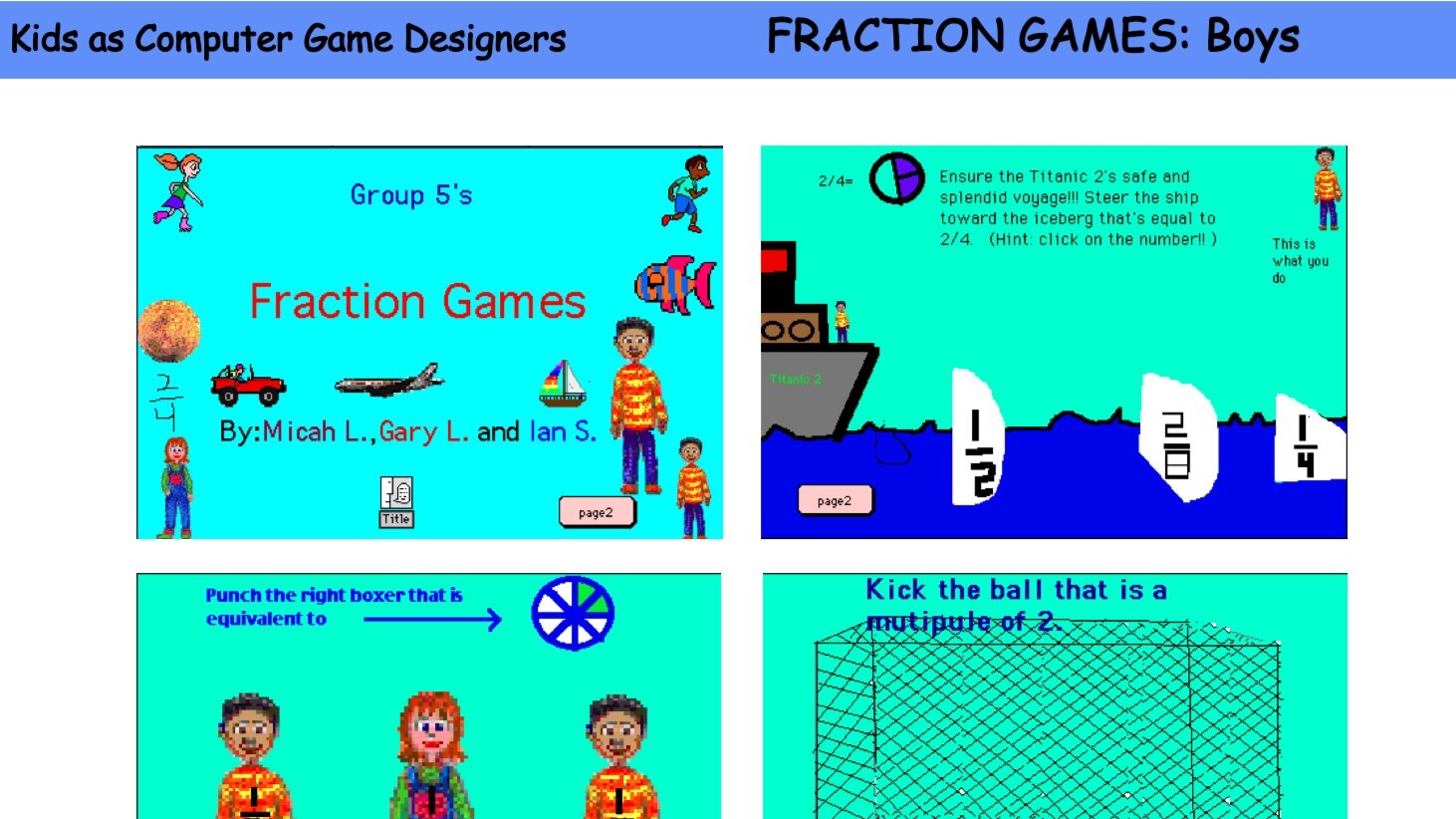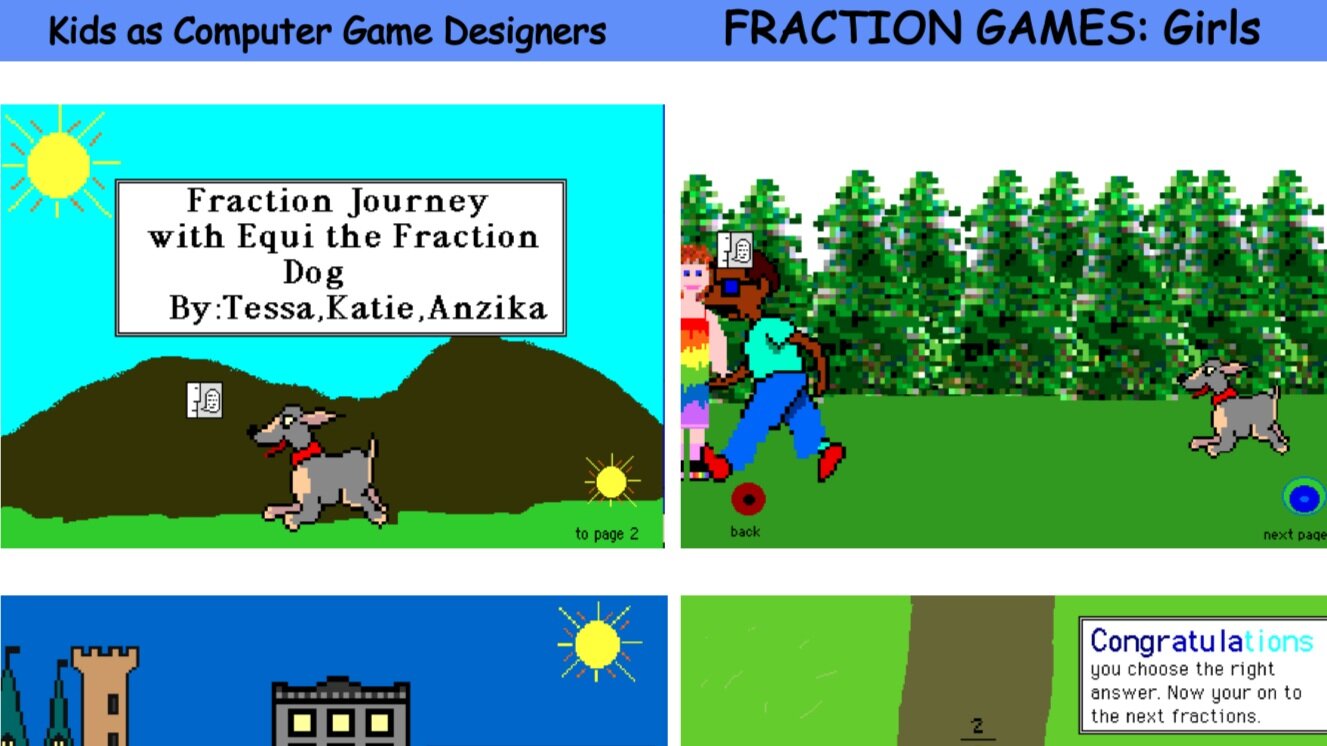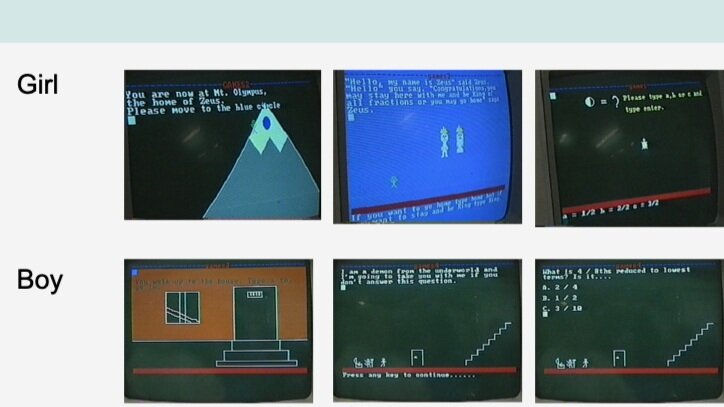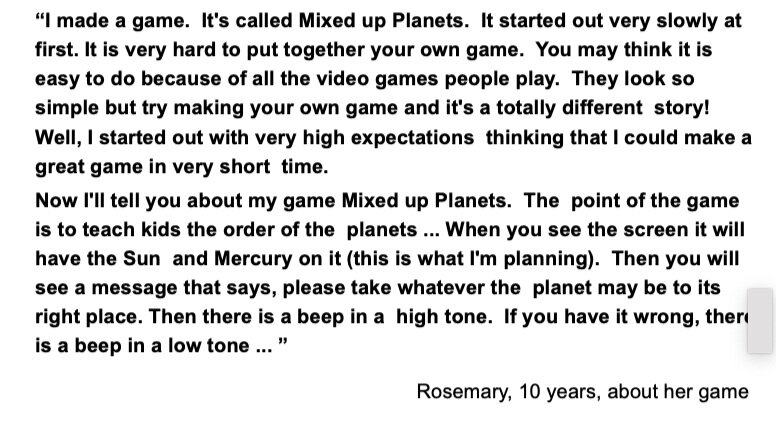Making Games for Learning
Serious gaming has mostly focused on playing games for learning. I have promoted constructionist approaches where children make their own games for learning. Rather than embedding “lessons” directly in games, constructionists have focused their efforts on providing students with greater opportunities to construct their own games—and to construct new relationships with knowledge in the process. Studies on constructionist gaming have expanded game making to include the design of new interfaces, wearable controllers and augmented board games. Furthermore, we have investigated the role of competitions and civic interactions in supporting learning.
Related Research
Fields, D. A. & Kafai, Y. B., Aguilerra, E., Slater, S. & Walker, J. T. (in press). Perspectives on Collaboration in and around Virtual Worlds and Sandbox Games. In U. Cress, C. Rose, A. Wise, and J. Otima (Eds.), International Handbook of Computer-Supported Collaborative Learning. New York, NY: Taylor & Francis.
Dishon, G. & Kafai, Y. B. (2020). Making more of games: Cultivating perspective-taking through game design. Computers & Education, 148, 103810 DOI: 10.1016/j.compedu.2020.103810
Dishon, G. & Kafai, Y. B. (2019). Connected civic gaming. Rethinking the role of video games in civic education. Interactive Learning Environments, 1-12. DOI: 10.1080/10494820.2019.1704791
Fields, D. A. & Kafai, Y. B. (2018). Games in the Learning Sciences: Reviewing Evidence from Playing and Making Games for Learning. In F. Fischer, C. Hmelo-Silver, P. Reimann, & S. Goldman, S. (Eds.), International Handbook of Learning Sciences (pp. 276-284). New York, NY: Taylor & Francis.
Kafai, Y. B. (2018). Constructionist Visions: Hard Fun with Serious Games. International Journal of Child-Computer Interaction, 18, 19-21.
Vasudevan, V. & Kafai, Y. B. (2016). Bridging Crafting and Computing in Making: Designing Interactive Touchpads and Gameboards with MaKey MaKey. In K. Peppler, E. Halverson & Y.B. Kafai M. (Eds.), Makeology: Makers as Learners, Volume 2 (pp. 145-160). New York, NY: Routledge.
Kafai, Y. B. & Burke, Q. (2015). Constructionist Gaming: Understanding the Benefits of Making Games for Learning. Educational Psychologist, 50(4), 313-334. Link to free access
Kafai, Y. B. & Vausdevan, V. (2015). Constructionist Gaming Beyond the Screen: Middle School Students’ Crafting and Computing of Touchpads, Board Games, and Controllers. In Proceedings of the 10th Workshop in Primary and Secondary Computing Education (WiPSCE '15) (pp. 49-54). New York, NY: Association for Computing Machinery. Link to PDF
Kafai, Y. B. & Vasudevean, V. (2015). Hi-Lo Tech Games: Crafting, Coding and Collaboration of Augmented Board Games by High School Youth. In Proceedings of the 14th International Conference on Interaction Design and Children (IDC '15) (pp. 130-139). New York, NY: Association for Computing Machinery. Link to PDF
Richard, G. T. & Kafai, Y. B. (2015). Responsive Make and Play: Youth Making Physically and Digitally Interactive and Wearable Controllers. In A. Nijholt (Ed.), More Playful User Interfaces, Gaming Media, and Social Effects (pp. 71- 93). Singapore: Springer.
Richard, G. & Kafai, Y. B. (2015). Making Physical and Digital Games with E-Textiles: A Workshop for Youth Making Responsive Wearable Games and Controllers. In Proceedings of the 14th International Conference on Interaction Design and Children (IDC '15) (pp. 399-402). New York, NY: Association for Computing Machinery. Link to PDF
Vasudevan, V., Kafai, Y. B. & Yang, L. (2015). Make, Wear, Play: Remix Designs of Wearable Controllers for Scratch Games by Middle School Youth. In Proceedings of the 14th International Conference on Interaction Design and Children (IDC '15) pp. 339-342). New York, NY: Association for Computing Machinery. Link to PDF
Burke, Q. & Kafai, Y.B. (2014). A decade of programming games for learning: From tools to communities. In H. Agius & M.C. Angelides (Eds.), The Handbook of Digital Games: Institute of Electrical and Electronics Engineers (IEEE) (pp. 689-709). New York: John Wiley & Sons.
Kafai, Y. B. (2014). Motivating and Broadening Participation in Competitions, Contests, Challenges, and Circles for Supporting STEM Learning (Symposium). In Polman, J. L., Kyza, E. A., O'Neill, D. K., Tabak, I., Penuel, W. R., Jurow, A. S., O'Connor, K., Lee, T., and D'Amico, L. (Eds.), Learning and becoming in practice: The International Conference of the Learning Sciences (ICLS) 2014, Volume 2. Boulder, CO: International Society of the Learning Sciences, pp. 1219-1227. Link to PDF
Kafai, Y. B. & Burke, Q. B. (2014). Connected Gaming: Moving from Instructionist to Constructionist Approaches in K-12 Serious Gaming. In Polman, J. L., Kyza, E. A., O'Neill, D. K., Tabak, I., Penuel, W. R., Jurow, A. S., O'Connor, K., Lee, T., and D'Amico, L. (Eds.), Learning and becoming in practice: The International Conference of the Learning Sciences (ICLS) 2014, Volume 2. Boulder, CO: International Society of the Learning Sciences, pp. 86-93. Link to PDF
Kafai, Y. B. & Burke, Q. B. (2014). Beyond Game Design for Broadening Participation: Building New Clubhouses of Computing for Girls. In Proceedings of Gender and IT Appropriation. Science and Practice on Dialogue–Forum for Interdisciplinary Exchange (Gender IT '14) (pp.21-28). Siegen, Germany: European Society for Socially Embedded Technologies. Link to PDF
Lee, E., Kafai, Y.B. Davis, R.L. & Vasudevan, V. (2014). Playing in the arcade: Designing tangible interfaces with MaKey MaKey for Scratch games. In A. Nijholt (Ed.), Playful User Interfaces: Interfaces that invite social and physical interaction (pp. 277 - 292). Singapore: Springer.
Davis, R., Kafai, Y. B., Vasudevan, V., & Lee, E. (2013). The education arcade: crafting, remixing, and playing with controllers for Scratch games. In Proceedings of the 12th International Conference on Interaction Design and Children (IDC '13) (pp. 439–442). Association for Computing Machinery, New York, NY, USA. Link to PDF
Mote, C., Kafai, Y. B., & Burke, Q. (2013). Virtual Design Competitions to Promote Communication, Collaboration, and Learning in Schools. Learning and Leading with Technology, 41(4), 16-21. Link to PDF
Vaseduvan, V., Davis, R. Kafai, Y. B., & Lee, E. (2013). Joystick Designs: Middle School Youth Crafting of Game Controllers. In Ochsner, A. & Dietmeier, J. (Eds.), Proceedings of the Games + Learning + Society Conference, Madison, WI. Link to PDF
Kafai, Y. B., Burke, W. Q., Mote, C. (2012). What makes things fun to participate? The role of audience for middle school game designers. In Proceedings of the 11th International Conference on Interaction Design and Children(IDC '12) (pp.284–287). Association for Computing Machinery, New York, NY, USA. Link to PDF
Peppler, K. A. & Kafai, Y. B. (2010). Gaming Fluencies: Pathways into Participatory Culture in a Community Design Studio. International Journal of Learning and Media, 1(4), 1-14.
Kafai, Y. B., Burke, W. Q, & Fields, D. A. (2009). What video game making can teach us about access and ethics in participatory culture. Proceedings of the Digital Interactive Games Research Association Conference (DiGRA 2009), London, UK. Link to PDF
Peppler, K. A. & Kafai, Y. B. (2007). What video game making can teach us about learning and literacy: Alternative pathways into participatory culture. In Akira Baba (Ed.), Situated Play: Proceedings of the Third International Conference of the Digital Games Research Association (DiGRA) (pp. 369-376). Tokyo, Japan: The University of Tokyo. Link to PDF
Kafai, Y. B. (2006). Playing and making games for learning: Instructionist and constructionist perspectives for game studies. Games and Culture, 1(1), 34-40. Link to PDF
Kafai, Y. B., Franke, M., Ching, C., & Shih, J. (1998). Games as interactive learning environments fostering teachers’ and students’ mathematical thinking. International Journal of Computers for Mathematical Learning, 3(2), 149–193.
